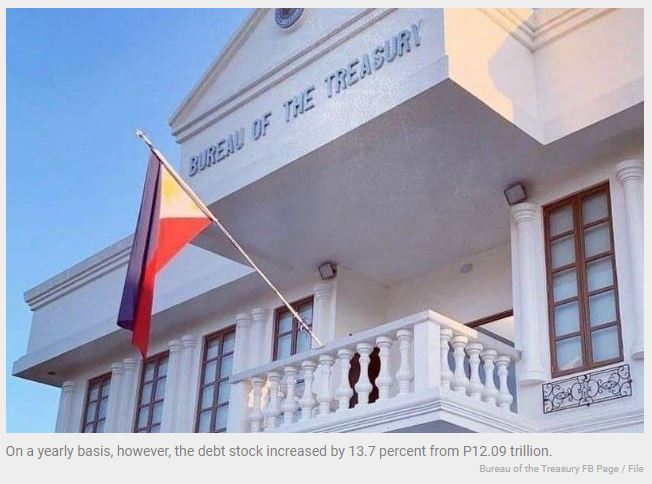Philippine debt rises to P13.75 trillion
MANILA, Philippines — The country’s outstanding debt increased to P13.75 trillion in February, reaching its highest level yet again, following the issuance of domestic securities as the government moves to finance the budget deficit.
Latest data from the Bureau of the Treasury showed that the national debt reached P13.75 trillion by end-February, inching up by just 0.4 percent from the P13.7 trillion level the month prior.
On a yearly basis, however, the debt stock increased by 13.7 percent from P12.09 trillion.
For the month of February, the government added some P54.26 billion in fresh obligations even after raising over P280 billion from the 5.5-year Retail Treasury Bonds (RTBs) during the month.
This was offset by the net repayment of some dues, in view of a relatively larger amount of maturities of T-bonds of roughly P260 billion that effectively reduced the government’s outstanding debt.
With this, the running debt incurred by the Marcos administration stood at P960.89 billion, closing in on the P1 trillion level in just eight months.
Rizal Commercial Banking Corp. chief economist Michael Ricafort said the latest net borrowings of the government may reflect the need to finance the budget deficits in recent months.
This is also attributed to the still elevated inflation that hiked state expenditures, as well as the high interest rates here and abroad that made debt servicing costs more expensive.
“There is also the still relatively weaker peso exchange rate versus the US dollar compared to a year ago that increased the peso equivalent of the government’s outstanding debts,” Ricafort said.
Moving forward, Ricafort said the government may pose new record highs in terms of debt.
It should be noted that the current debt pile is now about 94 percent of the expected P14.63 trillion debt by end-2023.
The government is expected to issue RTBs in the second quarter, as well as euro-denominated offering in the second half.
Meanwhile, the Treasury said that majority or 68.7 percent of the debt pile are domestic borrowings and the remaining 31.3 percent were sourced externally.
Total domestic debt at P9.44 trillion inched up 0.6 percent on a monthly basis, but jumped 12.2 percent from the P8.41 trillion recorded in February 2022.
The increase was attributed to the net availment of P55.88 billion in domestic financing and the P1.34 billion effect of local currency depreciation against the US dollar on foreign denominated onshore securities.
External obligations, on the other hand, barely moved month-on-month and stood at P4.31 trillion. However, it rose 17.1 percent from P3.68 trillion in the comparative period.
The Treasury said the slight reduction in external debt was due to the P21.15 billion net repayment of foreign loans, as well as the P32.32 billion impact of third-currency adjustments against the US dollar.
These outweighed the effect of local currency depreciation against the US dollar, which amounted to P50.51 billion.
Meanwhile, total debt guaranteed obligations went down by 1.7 percent to P387.19 billion due to the net repayment of both domestic and foreign guarantees amounting to P2.56 billion and P3.21 billion, respectively.
The peso depreciation trimmed P3.09 billion, more than offsetting the net depreciation of third-currency denominated guarantees against the US dollar amounting to P2.22 billion.
Source: https://www.philstar.com/business/2023/03/31/2255737/philippine-debt-rises-p1375-trillion


 English
English




